Title:
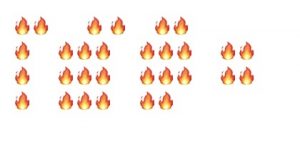
Plot:
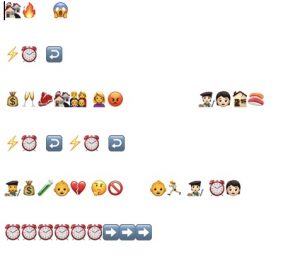
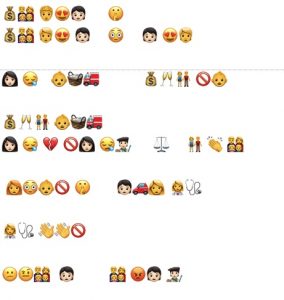
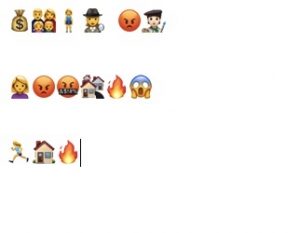
Emoji story analysis:
Using the conventional emoji keyboard has led me to discover there is not emoji for meerkat or wildebeest which meant I was not going to be able to retell The Lion King, the last movie I had watched, so it was on to the last novel read. This was going to be a challenge because although the title was simple, the story itself proved to be more difficult.
In order to guess this book title, you might need to be familiar with the book, if you are it should be easy to decipher. The plot might be as difficult to puzzle out as it was to write. And so I began with the title and wrote in ideas or concepts and groupings of words or ideas rather than in syllables which are only bites of sound meaning little.
The difficulties in my writing in emojis began with the plot of this story being circular rather than a linear plot line. Many books that I have read lately seem to actually tend to do this more complex plot line. A colleague (English department head) recently told me that First Nation stories often have a circular path and yes linear, circular and iterative are indeed in the English Arts Curriculum. The story begins at the end, then flashes back to an earlier time in the character’s line in order to explain the final scene. There is also a point where the plot flashes back yet again, twice actually.
Bolter claims that “[s]ince its invention, printing has placed the word effectively in control of the image” (48). In the case of emojis, they are incontrol as they become the words. Word choice is governed by the availability of emojis. I worried that I should not announce the gender of a character using a pink or blue shirt. I soon discovered that babies did not come in all colours and races which although not central to my plot would have helped. I tried to create groupings or “families” of character to make them more identifiable. Also missing were some occupations that I wanted as well as at least one medical procedure. And where was the pregnant emoji? Seriously? I was looking for that as well and was wondering how we petition for meerkats, wildebeests and pregnant people.
What was omitted also was interesting: no punctuation, spelling or grammar to worry about, although, I did section ideas into sort of sentences or lines as well as adding spaces between lines to create some semblance of paragraphs between ideas and spans of time. It was easier to create the pauses using a lack of text or by using spaces than it was with the earlier voice to text task. It would have been interesting to simply draw or move the emojis around in different arrangements but the document demanded a line after line arrangement following the conventions of English language. My emoji story retelling still has the constraints of the conservative arrangement of a book that Bolter (2001) describes.
Where do emojis fit into text? Kress describes written words and spoken to be a representation or “vague description” whereas an image is a more accurate representation. Bolter (2001) also makes an interesting point in that “ekphrasis sets out to rival visual art in words, to demonstrate that words can describe vivid scenes without recourse to pictures” . . . yet . . . “in digital media and even in print, we get a reverse ekphrasis in which images are given the task of explaining words (Ch 4. P. 56). Writing in emojis is a space that exists in this tension, in a sort of “no man’s land” which is neither image nor word. The emoji are a representation of words and become symbols of words which are what words are. Both are removed from the actual event and need to be interpreted by the reader.
This writing experience was definitely a challenge. Emojis were designed to add emotion to text especially in shorter pieces of writing, such as in tweets, messages and chats, to avoid misunderstandings that could arise (Bolter, Ch. 4). It is so hard to tell sometimes if someone ‘s message is being terse or sarcastic or just plain nasty or maybe they are just in a hurry. We rely on more than just written words to convey meaning. This is all great but emojis are designed for these short bursts of text instead of having to rely on lengthy explanations, whereas a novel has the time it takes to set a stage or scene(s) and use multitudes of descriptive language to create meaning. I have a text in my class library, YOLO Juliet and even it is not written in full emojis but more a rebus style with the odd emoji thrown in as well as being translated into a more modern slang version. According to Bolter: “Digital media claim to achieve greater immediacy and authenticity by integrating images (and sound) with prose.” (2001, Ch.4, 47). Notice that Bolter says “with”? Emojis are images but to rely totally on them does not create a full story or even plot; they paint a simple picture of emotions and objects but only of those that are available.
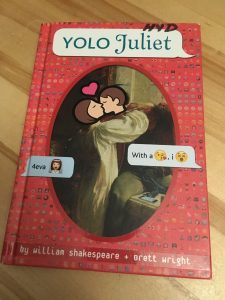
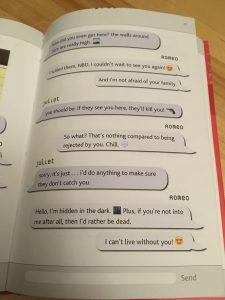
References:
Kress (2005), Gains and losses: New forms of texts, knowledge, and learning. Computers and Composition, Vol. 2(1), 5-22.
Bolter, J. D. (2001). Chapter 4. Writing space: Computers, hypertext, and the remediation of print (2nd ed.). Mahwah, N.J: Lawrence Erlbaum Associates. doi:10.4324/9781410600110
Shakespeare, W. & Wright, B.( 2015). YOLO Juliet. Random House.
Rebecca,
I just finished reading this novel the other day!!!! So funny. Gave a fist pump like I just won Jeopardy 🙂 Such a hard book to give a synopsis because of the interweaving and multi-dimensional characters. Well done!
Valerie
Thank you Valerie! I am so glad that you figured it out! I had tried once and quit then started The Lion King but couldn’t get the right emojis so back to this one. I missed a few of the nuances of the story and discovered that some keyboards do not have the emojis I was looking for – it is really hard to catch the complexities of a story with a limited vocabulary of the emojis available. This may be how Russian language speakers feel when they discover only one word for blue (Boroditsky). Finally struggle was when I discovered that my document did not copy and paste well – different devices, keyboards and platforms, so many layers. So, I am being to see the benefits of screen shots. Oh, and yes, you won!
Boroditsky, L. (June 2017). [Video]. How the languages we speak shape the way we think.
Little fires everywhere?
I haven’t read or watched this, but just a guess based on the first emoji capture.
The family emoji is really cute! I remember seeing on Twitter that if you type the family emoji into Google Docs and start pressing backspace, you start to delete one family member at a time :O
I will wait to confirm if you are correct or not, so as not to give away anything just yet. Based on the plot, would you wish to read this as yet to be named novel? Interesting way to “delete” family members :0 I think that if the emoji designers figured that out they could create more diversity in characters. Where are the meerkats and warthogs? Or members of different ethnic groups? There has been criticism that people do not see themselves reflected in books, so there should also be criticism of the lack of representation in text such as emojis. Sorry, that was a bit of a rant. Thanks for your comment 🙂
Hi Rebecca,
If I had to guess the plot, it looks like there are flashbacks and some time skips to explore these families and secrets. I think I’m really intrigued and want to read the book to confirm my understanding of the emoji story!
I realized there’s uncertainty around the handwaving, is this hello or goodbye?
I think you can select skin tones for some emojis! I was able to do this in the emojikeyboard, but I don’t know if I can on my phone. Regardless, this is a great point that there are limited emojis.
Hi Linda,
I am glad that someone recognized my attempts to create flashbacks. Stories often contain these “memory moments”(Beers and Probst, 2012) or flashbacks and these were crucial to the plot but describing them in emojis was difficult. The hand waving was to say “bye,” “bye” to a “problem’ after a visit to a medical professional. It is very callous way to put the issue but the way it is dealt with seemed simple to the characters but really wasn’t in the end and had terrible repercussions. I do recommend the story by read it before you watch it. I am now reading another of the authors as it really is intriguing if tragic. As to skin tones, yes I did see a variety of skin tones and hair for children and adults but not for the baby using the keyboard I had. Thanks for your comments.
Beers,K, & Probst. (2012) Note: Strategies for Close Reading.
I haven’t read this book but I have watched the tv show on Netflix – that is if I’m correct in guessing that it was recently placed on there? I don’t want to divulge the title, but I agree with a previous commentator!
When you said, “This is all great but emojis are designed for these short bursts of text instead of having to rely on lengthy explanations….” I couldn’t help but also think about novels turned graphic novels and how we are taking something that provides imagery, detail, descriptive language, and then to make it more appealing we cut it down to an emoji-style version, a comic.
You have made an interesting point about “cutting” the story down into a graphic novel but isn’t it ironic that we use language to describe an image , scene or action and then replace the language again with an image in a graphic novel? So image to words to images, sort of? Have you taught you students how to read a graphic novel or comic? I wonder if the reader notice some of the more subtle aspects or information embedded in image? There is also the wider audience accessibility With the graphic novel. But I do see the loss of some of the richer detail in the conversion much like Within the emoji storyLine. This will be an interesting task to try with our students. I wonder what they will think and how successful they will be?
Hi Rebecca, great job! I love that you spaced them out, unlike myself I just went for it. I think I know what you have here hmmmmm is it the same one I did? If it is, I love that we picked some of the same emoji’s and some different ones that I didn’t even think of. I like how you did the title. If we didn’t do the same one then I was way off on how I interpreted this. Good job!
I do believe you are on to something ThereTyler. While the medium is different and our use of emoticons, the titles are the same as is the general plot. Mine is from the book but I am unfamiliar with the series and how much Of the book is included. I didn’t get your title until I “read” the part about the burning house and I thought it must be the same story! (It is embarrassing how excited I was)It is interesting that my thought process grab this detail and considered it decisive. Yes, same story, I thought. The associative properties of the mind. I didn’t really even conscious of the spacing until you mentioned it. I did think in terms of grouping ideas or scenes together. I really felt compelled to make it as clear as I could because the storyline is so convoluted.
“I’ve been extremely impressed with the level of creativity and realandrare strategic thinking that this agency brings to the table.”